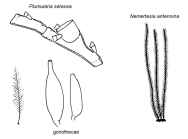Deep-Sea taxon details
Plumulariidae McCrady, 1859
1613 (urn:lsid:marinespecies.org:taxname:1613)
accepted
Family
- Genus Dentitheca Stechow, 1920
- Genus Nemertesia Lamouroux, 1812
- Genus Plumularia Lamarck, 1816
- Genus Pseudoplumaria Ramil & Vervoort, 1992
- Genus Antennularia Lamarck, 1816 accepted as Nemertesia Lamouroux, 1812
marine, fresh, terrestrial
Not documented
Schuchert, P. (2024). World Hydrozoa Database. Plumulariidae McCrady, 1859. Accessed through: Glover, A.G.; Higgs, N.; Horton, T. (2024) World Register of Deep-Sea species (WoRDSS) at: https://marinespecies.org/DeepSea/aphia.php?p=taxdetails&id=1613 on 2024-04-20
Glover, A.G.; Higgs, N.; Horton, T. (2024). World Register of Deep-Sea species (WoRDSS). Plumulariidae McCrady, 1859. Accessed at: https://marinespecies.org/deepsea/aphia.php?p=taxdetails&id=1613 on 2024-04-20
Date
action
by
2004-12-21 15:54:05Z
created
db_admin
context source (Hexacorallia)
Fautin, Daphne G. (2013). Hexacorallians of the World. (look up in IMIS) [details]
basis of record Calder D.R. (1997). Shallow-water hydroids of Bermuda: superfamily Plumularioidea. <em>Royal Ontario Museum Life Sciences Contributions.</em> 161: 1-86.
page(s): 8 [details]
basis of record Calder D.R. (1997). Shallow-water hydroids of Bermuda: superfamily Plumularioidea. <em>Royal Ontario Museum Life Sciences Contributions.</em> 161: 1-86.
page(s): 8 [details]
 Present
Present  Inaccurate
Inaccurate  Introduced: alien
Introduced: alien  Containing type locality
Containing type locality
From editor or global species database
Diagnosis Colonies erect, monosiphonic or polysiphonic, arising from creeping, rootlike, or disc-shaped hydrorhiza; hydrocauli branched or unbranched, hydrocladia alternate, opposite or in verticils, arising in polysiphonic hydrocauli from a single axial tube; hydrothecae typically small, uniseriate, usually at least partially adnate, occurring only on hydrocladia, with or without marginal cusps; nematophores with well developed nematothecae, not as naked sarcostyles; all nematothecae (axillar, cauline or hydrothecal) usually two-chambered (bithalamic) and movable, a minimum of three nematothecae adjacent to hydrothecae, one mesial inferior and a pair of lateral ones; gonophores as fixed sporosacs, exceptionally as swimming gonophores; gonothecae solitary, without nematothecae; with or without phylactocarps. [details]Spelling Spelling by Agassiz (1862: 358) was Plumularidae, Hincks (1868) introduced the correct spelling Plumulariidae. [details]








